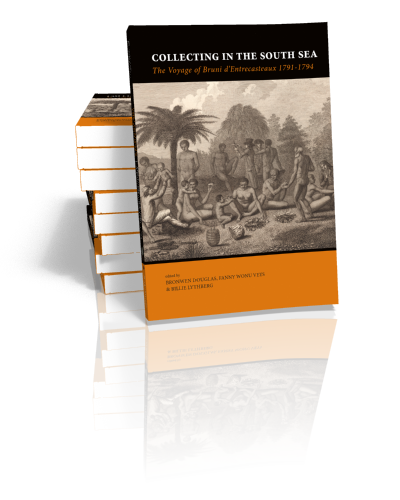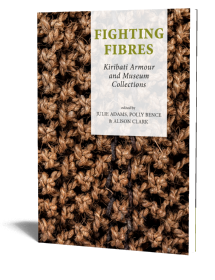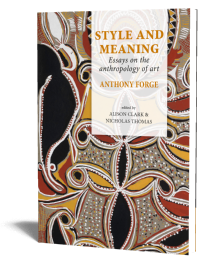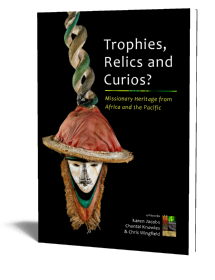Collecting in the South Sea
The Voyage of Bruni d’Entrecasteaux 1791-1794
Edited by Bronwen Douglas, Fanny Wonu Veys, and Billie Lythberg | 2018

Collecting in the South Sea
The Voyage of Bruni d’Entrecasteaux 1791-1794
Edited by Bronwen Douglas, Fanny Wonu Veys, and Billie Lythberg | 2018
Paperback ISBN: 9789088905742 | Hardback ISBN: 9789088905759 | Imprint: Sidestone Press | Format: 182x257mm | 382 pp. | Pacific Presences 3 | Language: English | 98 illus. (bw) | 202 illus. (fc) | Keywords: collecting, voyages, museums, material culture, art, archives, colonialism, encounters, exchange, Indigenous agency, Oceania | download cover
Read online or downloaded 2321 times
-
Digital & Online access
This is a full Open Access publication, click below to buy in print, browse, or download for free.
-
Buy via Sidestone (EU & UK)
-
Buy via our Distributors (WORLD)
For non-EU or UK destinations you can buy our books via our international distributors. Although prices may vary this will ensure speedy delivery and reduction in shipping costs or import tax. But you can also order with us directly via the module above.
UK international distributor
USA international distributor
-
Bookinfo
Paperback ISBN: 9789088905742 | Hardback ISBN: 9789088905759 | Imprint: Sidestone Press | Format: 182x257mm | 382 pp. | Pacific Presences 3 | Language: English | 98 illus. (bw) | 202 illus. (fc) | Keywords: collecting, voyages, museums, material culture, art, archives, colonialism, encounters, exchange, Indigenous agency, Oceania | download cover
Read online or downloaded 2321 times

We will plant a tree for each order containing a paperback or hardback book via OneTreePlanted.org.
This book is a study of ‘collecting’ undertaken by Joseph Antoine Bruni d’Entrecasteaux and his shipmates in Tasmania, the western Pacific Islands, and Indonesia. In 1791–1794 Bruni d’Entrecasteaux led a French naval expedition in search of the lost vessels of La Pérouse which had last been seen by Europeans at Botany Bay in March 1788. After Bruni d’Entrecasteaux died near the end of the voyage and the expedition collapsed in political disarray in Java, its collections and records were subsequently scattered or lost.
The book’s core is a richly illustrated examination, analysis, and catalogue of a large array of ethnographic objects collected during the voyage, later dispersed, and recently identified in museums in France, Norway, the Netherlands, Switzerland, and the United States. The focus on artefacts is informed by a broad conception of collecting as grounded in encounters or exchanges with Indigenous protagonists and also as materialized in other genres—written accounts, vocabularies, and visual representations (drawings, engravings, and maps).
Historically, the book outlines the antecedents, occurrences, and aftermath of the voyage, including its location within the classic era of European scientific voyaging (1766–1840) and within contemporary colonial networks. Particular chapters trace the ambiguous histories of the extant collections. Ethnographically, contributors are alert to local settings, relationships, practices, and values; to Indigenous uses and significance of objects; to the reciprocal, dialogic nature of collecting; to local agency or innovation in exchanges; and to present implications of objects and their histories, especially for modern scholars and artists, both Indigenous and non-Indigenous.
This books is part of the Pacific Presences series. Click here to see the other volumes in this series.
Abbreviations
Preface and Acknowledgements
PART I: PROLOGUE
1 History — Contexts, Voyage, People, Collections – Bronwen Douglas
Feature: The ‘Effets’ (effects) plates – Bronwen Douglas
2 Ethnohistory — Collecting and Representing – Bronwen Douglas
PART II: ARTEFACT COLLECTIONS
3 Object Trajectories, Webs of Relationships – Fanny Wonu Veys
4 Musée du Quai Branly – Jacques Chirac, Paris – Bronwen Douglas
Feature: bwar — Kanak hache-ostensoir, ceremonial axe – Bronwen Douglas
Feature: sisi fale — Tongan coconut fibre waist garment – Billie Lythberg and Melenaite Taumoefolau
5 Musée des Beaux-Arts, Dunkerque – Claude Steen-Guélen and Hélène Guiot
Feature: kie — Tongan small fine mat – Hélène Guiot
6 Universitetsmuseet, Bergen – Knut Rio
Feature: Encountering Māori and their artefacts – Billie Lythberg and Mānuka Hēnare
Feature Archery equipment – Andy Mills
7 Kulturhistorisk Museum, University of Oslo – Arne Aleksej Perminow
8 Museum Volkenkunde – Nationaal Museum van Wereldculturen, Leiden – Fanny Wonu Veys
Feature Tongan ships carving Fanny Wonu Veys
Feature helu tu‘u — Tongan comb and hair dressing – Billie Lythberg and Melenaite Taumoefolau
9 Tropenmuseum – Nationaal Museum van Wereldculturen, Leiden – Tristan Mostert
10 Zeeuws Museum, Middelburg – Caroline van Santen
11 Peabody Museum of Archaeology and Ethnology at Harvard University, Cambridge, MA – Fanny Wonu Veys
Feature kali — Tongan headrests – Fanny Wonu Veys_
12 Musée cantonal d’Archéologie et d’Histoire, Lausanne – Claire Brizon, Claude Leuba, and Lionel Pernet with Fanny Wonu Veys and Bronwen Douglas
Feature Absent objects, Muséum d’Histoire naturelle du Havre – Thierry Vincent
PART III: OTHER COLLECTIONS
13 Drawings and Engravings – Bronwen Douglas
Feature tayenebe, exchange — Reviving Aboriginal fibre work in Tasmania – Julie Gough
Feature kupesi — Tongan design structure and Piron’s experiment – Billie Lythberg and Semisi Fetokai Potauaine
14 Tongan Wordlists – Paul Geraghty
15 Tongan Musical Instruments – Fanny Wonu Veys, Billie Lythberg, and Rachel Hand with Tavake-fai-‘ana Semisi Fetokai Potauaine
PART IV: RE-INTERPRETATIONS AND TRANSFORMATIONS
16 Cultural Currents — Tongan and Fijian Sculpture – Andy Mills
17 Tongans in 1793 Phyllis Herda and Bronwen Douglas
18 Translation and Transformation — Piron’s Drawings – Nicola Dickson
Feature Lisa Reihana’s Emissaries – Billie Lythberg
PART V: EPILOGUE
19 Reflections Nicholas Thomas
PART VI: CATALOGUE
Appendix 1 Catalogue of the objects – Fanny Wonu Veys, Billie Lythberg, and Andy Mills
Appendix 2 List of Objects by Institution – Fanny Wonu Veys and Billie Lythberg
Appendix 3 List of Objects by Provenance – Fanny Wonu Veys and Bronwen Douglas
Contributors
Figures
References
Index
Prof. dr. Bronwen Douglas
Bronwen Douglas is honorary professor at the Australian National University in Canberra where she was fellow and senior fellow from 1997–2012. She was previously lecturer and senior lecturer at La Trobe University (Melbourne, Australia) from 1971–1996. A historian of science focussing on Oceania, her main research field is the interplay of global ideas of human difference, race, and geography in European encounters with particular Oceanian people, places, and agency.
Dr. Fanny Wonu Veys
Fanny Wonu Veys is curator Oceania at the National Museum of World Cultures, a Dutch umbrella organization comprising the Tropenmuseum, Amsterdam; Museum Volkenkunde, Leiden; the Afrika Museum, Berg en Dal; and the Wereldmuseum, Rotterdam. She has previously worked at the Museum of Archaeology and Anthropology in Cambridge (UK) (2004–2006, 2008–2009) and has held postdoctoral fellowships at the Metropolitan Museum of Art (New York) (2006–2007) and at the Musée du Quai Branly (Paris) (2007–2008).
Dr. Billie Lythberg
Billie Lythberg has been senior research fellow at the University of Auckland Business School (NZ) since 2013, working at the junction of economics, anthropology, and history. Her research interests include Oceanic sciences, arts, and oral histories; cross-cultural theories of value, valuables, and valuation; sustainability and environmental management; and social innovation.
Abstract:
This book is a study of ‘collecting’ undertaken by Joseph Antoine Bruni d’Entrecasteaux and his shipmates in Tasmania, the western Pacific Islands, and Indonesia. In 1791–1794 Bruni d’Entrecasteaux led a French naval expedition in search of the lost vessels of La Pérouse which had last been seen by Europeans at Botany Bay in March 1788. After Bruni d’Entrecasteaux died near the end of the voyage and the expedition collapsed in political disarray in Java, its collections and records were subsequently scattered or lost.
The book’s core is a richly illustrated examination, analysis, and catalogue of a large array of ethnographic objects collected during the voyage, later dispersed, and recently identified in museums in France, Norway, the Netherlands, Switzerland, and the United States. The focus on artefacts is informed by a broad conception of collecting as grounded in encounters or exchanges with Indigenous protagonists and also as materialized in other genres—written accounts, vocabularies, and visual representations (drawings, engravings, and maps).
Historically, the book outlines the antecedents, occurrences, and aftermath of the voyage, including its location within the classic era of European scientific voyaging (1766–1840) and within contemporary colonial networks. Particular chapters trace the ambiguous histories of the extant collections. Ethnographically, contributors are alert to local settings, relationships, practices, and values; to Indigenous uses and significance of objects; to the reciprocal, dialogic nature of collecting; to local agency or innovation in exchanges; and to present implications of objects and their histories, especially for modern scholars and artists, both Indigenous and non-Indigenous.
This books is part of the Pacific Presences series. Click here to see the other volumes in this series.
Contents
Abbreviations
Preface and Acknowledgements
PART I: PROLOGUE
1 History — Contexts, Voyage, People, Collections – Bronwen Douglas
Feature: The ‘Effets’ (effects) plates – Bronwen Douglas
2 Ethnohistory — Collecting and Representing – Bronwen Douglas
PART II: ARTEFACT COLLECTIONS
3 Object Trajectories, Webs of Relationships – Fanny Wonu Veys
4 Musée du Quai Branly – Jacques Chirac, Paris – Bronwen Douglas
Feature: bwar — Kanak hache-ostensoir, ceremonial axe – Bronwen Douglas
Feature: sisi fale — Tongan coconut fibre waist garment – Billie Lythberg and Melenaite Taumoefolau
5 Musée des Beaux-Arts, Dunkerque – Claude Steen-Guélen and Hélène Guiot
Feature: kie — Tongan small fine mat – Hélène Guiot
6 Universitetsmuseet, Bergen – Knut Rio
Feature: Encountering Māori and their artefacts – Billie Lythberg and Mānuka Hēnare
Feature Archery equipment – Andy Mills
7 Kulturhistorisk Museum, University of Oslo – Arne Aleksej Perminow
8 Museum Volkenkunde – Nationaal Museum van Wereldculturen, Leiden – Fanny Wonu Veys
Feature Tongan ships carving Fanny Wonu Veys
Feature helu tu‘u — Tongan comb and hair dressing – Billie Lythberg and Melenaite Taumoefolau
9 Tropenmuseum – Nationaal Museum van Wereldculturen, Leiden – Tristan Mostert
10 Zeeuws Museum, Middelburg – Caroline van Santen
11 Peabody Museum of Archaeology and Ethnology at Harvard University, Cambridge, MA – Fanny Wonu Veys
Feature kali — Tongan headrests – Fanny Wonu Veys_
12 Musée cantonal d’Archéologie et d’Histoire, Lausanne – Claire Brizon, Claude Leuba, and Lionel Pernet with Fanny Wonu Veys and Bronwen Douglas
Feature Absent objects, Muséum d’Histoire naturelle du Havre – Thierry Vincent
PART III: OTHER COLLECTIONS
13 Drawings and Engravings – Bronwen Douglas
Feature tayenebe, exchange — Reviving Aboriginal fibre work in Tasmania – Julie Gough
Feature kupesi — Tongan design structure and Piron’s experiment – Billie Lythberg and Semisi Fetokai Potauaine
14 Tongan Wordlists – Paul Geraghty
15 Tongan Musical Instruments – Fanny Wonu Veys, Billie Lythberg, and Rachel Hand with Tavake-fai-‘ana Semisi Fetokai Potauaine
PART IV: RE-INTERPRETATIONS AND TRANSFORMATIONS
16 Cultural Currents — Tongan and Fijian Sculpture – Andy Mills
17 Tongans in 1793 Phyllis Herda and Bronwen Douglas
18 Translation and Transformation — Piron’s Drawings – Nicola Dickson
Feature Lisa Reihana’s Emissaries – Billie Lythberg
PART V: EPILOGUE
19 Reflections Nicholas Thomas
PART VI: CATALOGUE
Appendix 1 Catalogue of the objects – Fanny Wonu Veys, Billie Lythberg, and Andy Mills
Appendix 2 List of Objects by Institution – Fanny Wonu Veys and Billie Lythberg
Appendix 3 List of Objects by Provenance – Fanny Wonu Veys and Bronwen Douglas
Contributors
Figures
References
Index
Prof. dr. Bronwen Douglas
Bronwen Douglas is honorary professor at the Australian National University in Canberra where she was fellow and senior fellow from 1997–2012. She was previously lecturer and senior lecturer at La Trobe University (Melbourne, Australia) from 1971–1996. A historian of science focussing on Oceania, her main research field is the interplay of global ideas of human difference, race, and geography in European encounters with particular Oceanian people, places, and agency.
Dr. Fanny Wonu Veys
Fanny Wonu Veys is curator Oceania at the National Museum of World Cultures, a Dutch umbrella organization comprising the Tropenmuseum, Amsterdam; Museum Volkenkunde, Leiden; the Afrika Museum, Berg en Dal; and the Wereldmuseum, Rotterdam. She has previously worked at the Museum of Archaeology and Anthropology in Cambridge (UK) (2004–2006, 2008–2009) and has held postdoctoral fellowships at the Metropolitan Museum of Art (New York) (2006–2007) and at the Musée du Quai Branly (Paris) (2007–2008).
Dr. Billie Lythberg
Billie Lythberg has been senior research fellow at the University of Auckland Business School (NZ) since 2013, working at the junction of economics, anthropology, and history. Her research interests include Oceanic sciences, arts, and oral histories; cross-cultural theories of value, valuables, and valuation; sustainability and environmental management; and social innovation.
-
Digital & Online access
This is a full Open Access publication, click below to buy in print, browse, or download for free.
-
Buy via Sidestone (EU & UK)
-
Buy via our Distributors (WORLD)
For non-EU or UK destinations you can buy our books via our international distributors. Although prices may vary this will ensure speedy delivery and reduction in shipping costs or import tax. But you can also order with us directly via the module above.
UK international distributor
USA international distributor
- Browse all books by subject
-
Search all books

We will plant a tree for each order containing a paperback or hardback book via OneTreePlanted.org.
You might also like:
© 2026 Sidestone Press KvK nr. 28114891 Privacy policy Sidestone Newsletter Terms and Conditions (Dutch)








